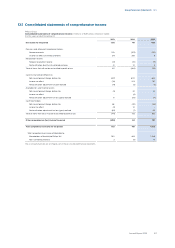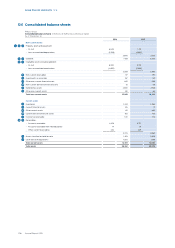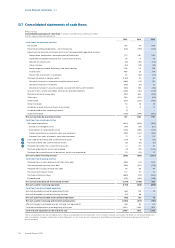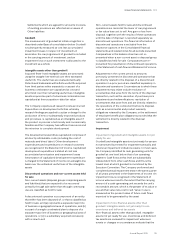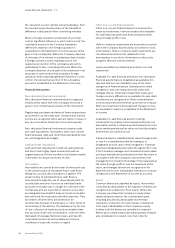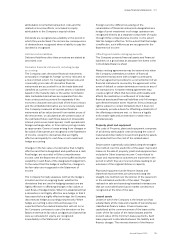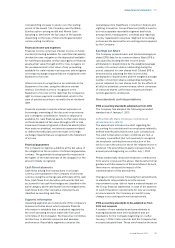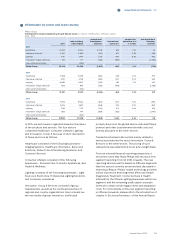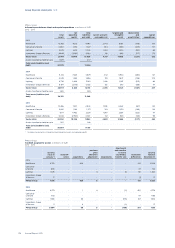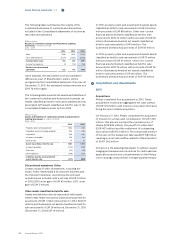Philips 2015 Annual Report Download - page 116
Download and view the complete annual report
Please find page 116 of the 2015 Philips annual report below. You can navigate through the pages in the report by either clicking on the pages listed below, or by using the keyword search tool below to find specific information within the annual report.Group nancial statements 12.9
116 Annual Report 2015
carrying amount of an asset may not be recoverable.
Recoverability of assets to be held and used is
recognized and measured by a comparison of the
carrying amount of an asset with the greater of its value
in use and fair value less cost to sell. Value in use is
measured as the present value of future cash ows
expected to be generated by the asset. If the carrying
amount of an asset is deemed not recoverable, an
impairment charge is recognized in the amount by
which the carrying amount of the asset exceeds the
recoverable amount. The review for impairment is
carried out at the level where cash ows occur that are
independent of other cash ows.
Impairment losses recognized in prior periods are
assessed at each reporting date for any indications that
the loss has decreased or no longer exists. An
impairment loss is reversed if and to the extent there
has been a change in the estimates used to determine
the recoverable amount. The loss is reversed only to the
extent that the asset’s carrying amount does not exceed
the carrying amount that would have been determined,
net of depreciation or amortization, if no impairment
loss had been recognized. Reversals of impairment are
recognized in the Statement of income.
Impairment of nancial assets
A nancial asset is considered to be impaired if
objective evidence indicates that one or more events
have had a negative eect on the estimated future cash
ows of that asset. In case of available-for-sale
nancial assets, a signicant or prolonged decline in the
fair value of the nancial assets below its cost is
considered an indicator that the nancial assets are
impaired. If any such evidence exists for available-for-
sale nancial assets, the cumulative loss - measured as
the dierence between the acquisition cost and the
current fair value, less any impairment loss on that
nancial asset previously recognized in the Statement
of income - is reclassied from the fair value reserve in
equity (through Other comprehensive income) to the
Statement of income.
If objective evidence indicates that nancial assets that
are carried at cost need to be tested for impairment,
calculations are based on information derived from
business plans and other information available for
estimating their fair value, which is based on estimated
future cash ows discounted at the asset’s original
eective interest rate. Any impairment loss is charged
to the Statement of income.
An impairment loss related to nancial assets is
reversed if in a subsequent period, the fair value
increases and the increase can be related objectively to
an event occurring after the impairment loss was
recognized. The loss is reversed only to the extent that
the asset’s carrying amount does not exceed the
carrying amount that would have been determined if no
impairment loss had been recognized. Reversals of
impairment are recognized in the Statement of income
except for reversals of impairment of available-for-sale
equity securities, which are recognized in Other
comprehensive income.
Other policies
Basis of consolidation
The Consolidated nancial statements comprise the
nancial statements of Koninklijke Philips N.V. and all
subsidiaries that the Company controls, i.e. when it is
exposed, or has rights, to variable returns from its
involvement with the investee and has the ability to
aect those returns through its power over the investee.
The existence and eect of potential voting rights are
considered when assessing whether the Company
controls another entity. Subsidiaries are fully
consolidated from the date that control commences
until the date that control ceases. All intercompany
balances and transactions have been eliminated in the
Consolidated nancial statements. Unrealized losses
are eliminated in the same way as unrealized gains, but
only to the extent that there is no evidence of
impairment.
Business combinations
Business combinations are accounted for using the
acquisition method. Under the acquisition method, the
identiable assets acquired, liabilities assumed and any
non-controlling interest in the acquiree are recognized
at the acquisition date, which is the date on which
control is transferred to the Company.
The Company measures goodwill at the acquisition
date as:
• the fair value of the consideration transferred; plus
• the recognized amount of any non-controlling
interest in the acquiree; plus
•if the business combination is achieved in stages, the
fair value of the existing equity interest in the
acquiree; less
• the net recognized amount (generally fair value) of
the identiable assets acquired and liabilities
assumed.
Costs related to the acquisition, other than those
associated with the issue of debt or equity securities,
that the Company incurs are expensed as incurred.
Any contingent consideration payable is recognized at
fair value at the acquisition date and initially is
presented as Long-term provisions. When the timing
and amount of the consideration become more certain,
it is reclassied to Accrued liabilities. If the contingent
consideration that meets the denition of a nancial
instrument is classied as equity, it is not remeasured
and settlement is accounted for within equity.
Otherwise, subsequent changes to the fair value of the
contingent consideration are recognized in the
Statement of income.



